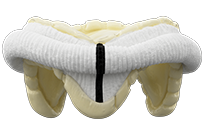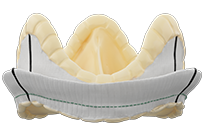For decades, Epic™ has been the surgical valve platform that cardiac surgeons and patients have relied on for more. More flexibility. More possibilities.
That’s why, at Abbott, we’ve developed the Epic Platform to provide the same trusted durability and performance — plus even more.
Built on the proven legacy of its predecessors, the Epic Plus valve delivers everything you’ve come to expect from Epic — plus significant improvements to radiopacity and implantability to enable future interventions and implantation for even the most challenging patient anatomies.
With the Epic Plus valve you and your patients can continue to depend on the Epic Platform for more — both now and in the future. Reliable therapy for today, possibilities for tomorrow.
Now that’s Epic. By Design.
Learn about the features of the Epic™ Plus Mitral and Aortic Stented Tissue Valves.


| Model Number | Valve Size (mm) | Tissue Annulus Diameter (mm) | Internal Diameter (Stent ID mm) | Ventricular Protrusion (mm) | Total Height (mm) | Cuff Outer Diameter (mm) |
|---|---|---|---|---|---|---|
| E200-25M | 25 | 25 | 22.6 | 9 | 16 | 33 |
| E200-27M | 27 | 27 | 24.5 | 9 | 17 | 35 |
| E200-29M | 29 | 29 | 26.3 | 10 | 19 | 37 |
| E200-31M | 31 | 31 | 28.4 | 10 | 20 | 39 |
| E200-33M | 33 | 33 | 30.3 | 11 | 20 | 41 |
| Model Number | Valve Size (mm) | Tissue Annulus Diameter (mm) | Internal Diameter (Stent ID mm) | Aortic Protrusion (mm) | Total Height (mm) | Cuff Outer Diameter (mm) |
|---|---|---|---|---|---|---|
| ESP200-19 | 19 | 19 | 18.7 | 11 | 14 | 25 |
| ESP200-21 | 21 | 21 | 20.8 | 11 | 15 | 28 |
| ESP200-23 | 23 | 23 | 22.6 | 13 | 16 | 29 |
| ESP200-25 | 25 | 25 | 24.5 | 13 | 17 | 31 |
| ESP200-27 | 27 | 27 | 26.3 | 14 | 19 | 33 |
| Model Number | Description |
|---|---|
| E2000 | Bioprosthetic Heart Valve Sizer Set One (1) click-in Aortic holder handle One (1) Screw-in holder handle Six (6) double-ended aortic/Supra sizers (19, 21, 23, 25, 27, 29) Five (5) mitral sizers (25, 27, 29, 31, 33) One (1) autoclavable tray for storage of components One (1) autoclavable tray cover |
| E2000-HA | Replacement handle One (1) click-in Aortic holder handle |
| E2000 HM | Replacement handle One (1) Screw-in Mitral holder handle |

Indications for Use
The Epic™ Plus valve is indicated for patients requiring replacement of a diseased, damaged, or malfunctioning native aortic and/or mitral heart valve. It may also be used as a replacement for a previously implanted aortic and/or mitral prosthetic heart valve.
The Epic™ Plus Supra valve is indicated for patients requiring replacement of a diseased, damaged, or malfunctioning native aortic heart valve. It may also be used as a replacement for a previously implanted aortic prosthetic heart valve.
Contraindications
None known.
Potential Adverse Events
Adverse events potentially associated with the use of bioprosthetic heart valves (in alphabetical order) include: angina; cardiac arrhythmias; endocarditis; heart failure; hemolysis; hemolytic anemia; hemorrhage, anticoagulant/antiplatelet-related; leak, transvalvular or paravalvular; myocardial infarction; nonstructural dysfunction (entrapment by pannus or suture, inappropriate sizing or positioning, or other); prosthesis regurgitation; stroke; structural deterioration (calcification, leaflet tear, or other); thromboembolism; valve thrombosis.
It is possible that these complications could lead to: reoperation; explantation; permanent disability;
death.
MAT-2011664 v3.0
Stay Connected